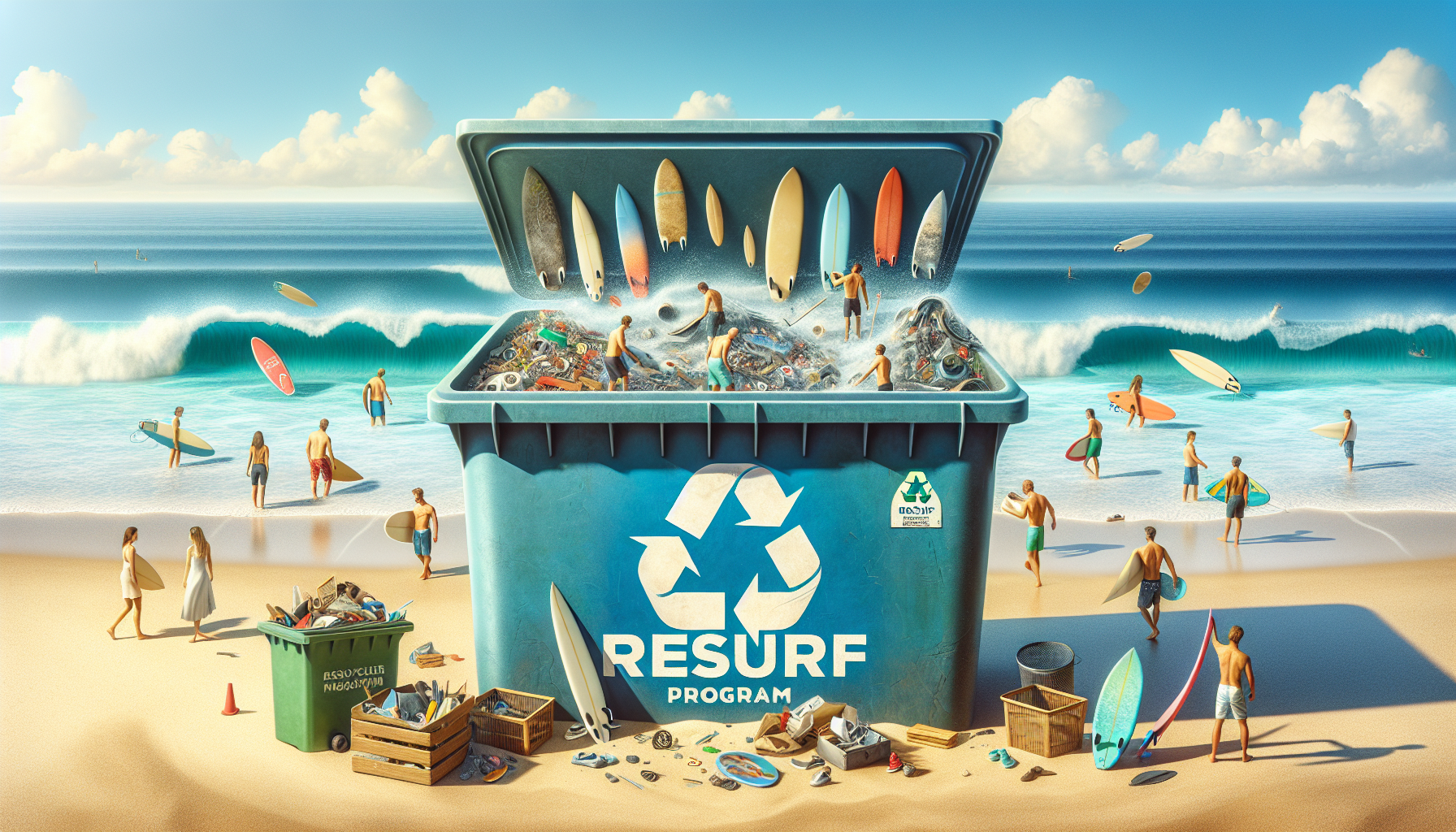
ReSurf program overview
The ReSurf Program is a forward-thinking initiative launched by Surfrider Foundation Canada to tackle the growing issue of waste within the surfing community. Focused on extending the life cycle of surf gear, the program encourages surfers to donate used or unwanted equipment such as surfboards, wetsuits, leashes, and fins. Rather than allowing these items to end up in landfills, ReSurf gives them a second life through redistribution, repair, or repurposing.
By creating a circular system for surf gear, the program not only reduces environmental impact but also makes surfing more accessible to individuals who may not be able to afford new equipment. The initiative is structured around local collection points and partnerships with surf shops, community centres, and environmental organisations, making it easy for surfers to participate.
ReSurf also includes educational components aimed at raising awareness about sustainable practices in the surfing world. Through workshops, social media campaigns, and community events, the program promotes a culture of reuse and environmental responsibility among surfers of all levels.
With its practical approach and strong community focus, the ReSurf Program is setting a new standard for sustainability in the surf industry, offering a model that could be replicated in coastal communities across Australia and beyond.
Environmental impact and sustainability goals
One of the core objectives of the ReSurf Program is to significantly reduce the environmental footprint of the surfing industry, which has long struggled with the issue of non-biodegradable waste. Traditional surf gear, particularly items like neoprene wetsuits and fibreglass surfboards, can take hundreds of years to break down in landfill conditions. By diverting these materials from waste streams and extending their usability, ReSurf directly addresses the problem of surf-related pollution.
The program aligns with broader sustainability goals by promoting a circular economy within the surfing community. Instead of following the conventional linear model of production, use, and disposal, ReSurf encourages a loop where gear is reused, repaired, or creatively repurposed. This not only conserves raw materials and reduces manufacturing emissions but also lessens the demand for new products, which often come with a heavy carbon footprint due to global supply chains and energy-intensive production processes.
In addition to waste reduction, ReSurf is committed to lowering the overall environmental impact of surfing culture. The initiative supports local repair workshops that teach surfers how to fix their own gear, reducing the need for replacements and empowering individuals to take responsibility for their environmental choices. These workshops also highlight eco-friendly alternatives and innovations in surf gear design, such as biodegradable waxes and recycled materials, helping to shift consumer habits toward more sustainable options.
By fostering a mindset of conservation and conscious consumption, ReSurf contributes to healthier coastal ecosystems. Less waste on land means less risk of debris entering the ocean, where it can harm marine life and degrade water quality. The program’s emphasis on sustainability resonates strongly with Australian surfers, many of whom are already passionate about protecting the beaches and waves they love.
Ultimately, the environmental goals of ReSurf go beyond just gear recycling—they aim to inspire a cultural shift within the surfing community. Through education, accessibility, and practical action, the program is helping to build a future where surfing and sustainability go hand in hand.
Community involvement and gear donation process
At the heart of the ReSurf Program is a strong emphasis on community engagement, recognising that meaningful environmental change starts with grassroots participation. Surfrider Foundation Canada has designed the initiative to be as inclusive and accessible as possible, encouraging surfers of all ages and skill levels to get involved in the gear donation process. Whether you’re a seasoned wave rider with a garage full of old boards or a beginner upgrading your first wetsuit, there’s a place for everyone in the ReSurf movement.
Donating gear is straightforward and convenient. The program has established a network of drop-off points at local surf shops, community centres, and eco-conscious retailers across participating regions. These locations are clearly marked and promoted through social media and local outreach, making it easy for surfers to find a nearby spot to contribute their used equipment. In some areas, mobile collection events are also organised, where volunteers set up temporary donation stations at popular beaches and surf competitions.
Once collected, the gear is sorted and assessed for its condition. Items that are still functional are cleaned and redistributed to individuals or community programs in need, such as surf schools, youth outreach initiatives, and coastal First Nations communities. Equipment that requires minor repairs is sent to local workshops, where volunteers and skilled technicians restore it for continued use. Even gear that’s beyond repair is not wasted—it may be repurposed into art, furniture, or other creative projects that highlight the importance of sustainability in surf culture.
Community involvement goes beyond just donating gear. The ReSurf Program actively encourages volunteers to participate in repair days, educational events, and awareness campaigns. These gatherings not only foster a sense of camaraderie among surfers but also provide hands-on learning opportunities about sustainable practices. Many Australian surfers have found these events to be a rewarding way to give back to the ocean and the community that surrounds it.
To further support engagement, ReSurf collaborates with local schools, surf clubs, and environmental groups to host workshops and presentations. These sessions often include demonstrations on how to repair common gear issues, discussions on the environmental impact of surf equipment, and tips for making more sustainable choices when purchasing new gear. By involving the community at every level, the program ensures that the message of sustainability is not just heard, but lived.
Through this collaborative approach, ReSurf is building a culture of shared responsibility and environmental stewardship within the surfing community. It’s a model that resonates strongly with Australian values of mateship, outdoor living, and respect for nature—making it a natural fit for coastal communities across the country.
ReSurf program goals and impact
Mate, we all know the ocean gives us everything — barrels, fish, and freedom. But it’s time we gave something back. That’s where the ReSurf Program comes in. Spearheaded by Surfrider Foundation Canada, this beauty of an initiative is all about keeping busted boards, worn-out wetsuits, and other surf gear out of the tip and back into the lineup.
The goal? Simple. Cut down on landfill waste and give old gear a second life. Whether it’s a snapped stick or a wetsuit that’s seen one too many winters, ReSurf is turning trash into treasure. They’re working with local legends, surf shops, and eco-minded shredders to collect, refurbish, and redistribute gear that still has some salt left in it.
“We’re not just saving gear — we’re saving stories,” said one of the program’s organisers. “Every board has a past, and with ReSurf, it gets a future too.”
Since the launch, the program’s already diverted a solid chunk of surf waste from landfill. That’s less junk clogging up the planet and more gear getting a second crack at the swell. It’s sustainability with a salty twist — and it’s catching on faster than a Nor’easter swell.
- Old boards are being repaired and donated to groms who can’t afford new gear.
- Wetsuits are being upcycled into everything from stubby holders to yoga mats (yep, really).
- Broken fins and leashes are being repurposed into art and functional gear.
It’s a win for the ocean, a win for the community, and a win for anyone who’s ever cried over a snapped board. So next time your gear cops a flogging, think twice before chucking it — ReSurf might just give it a second ride.
How the surfing community can get involved
Getting amongst the ReSurf Program is easier than waxing up your board on a summer arvo. Whether you’re a salty old sea dog or a fresh-faced frother, there’s a way to pitch in and keep the stoke alive — sustainably.
- Donate your old gear: Got a board that’s more dings than deck? Or a wetsuit that smells like low tide? Drop it off at a participating surf shop or community hub. ReSurf’s got collection points popping up faster than bluebottles in a nor’easter.
- Host a gear swap: Round up your crew and throw a local swap meet. Trade boards, wetsuits, fins — whatever’s gathering dust in the shed. It’s like a garage sale, but with more wax and less lawnmowers.
- Volunteer your skills: Handy with a sander? Know your way around neoprene? ReSurf’s always keen for legends who can help fix up gear or run workshops. Bonus points if you bring snacks.
- Spread the word: Not everyone’s heard of ReSurf yet, so give it a shout on your socials, at the pub, or in the lineup. The more crew on board, the bigger the impact.
“It’s not just about recycling — it’s about reconnecting with the surf community and giving back to the ocean that gives us so much,” said a local surfer who’s been donating boards since day one.
And if you’re a surf shop owner or part of a boardriders club, you can register as a drop-off point or partner with ReSurf to run events. It’s a ripper way to get your local scene involved and show the groms what real surf culture looks like — community, care, and a whole lotta stoke.
So next time you’re packing the ute for a dawn patrol, chuck that old gear in too. It might just be someone else’s ticket to their first wave — and that’s a feeling worth recycling.

